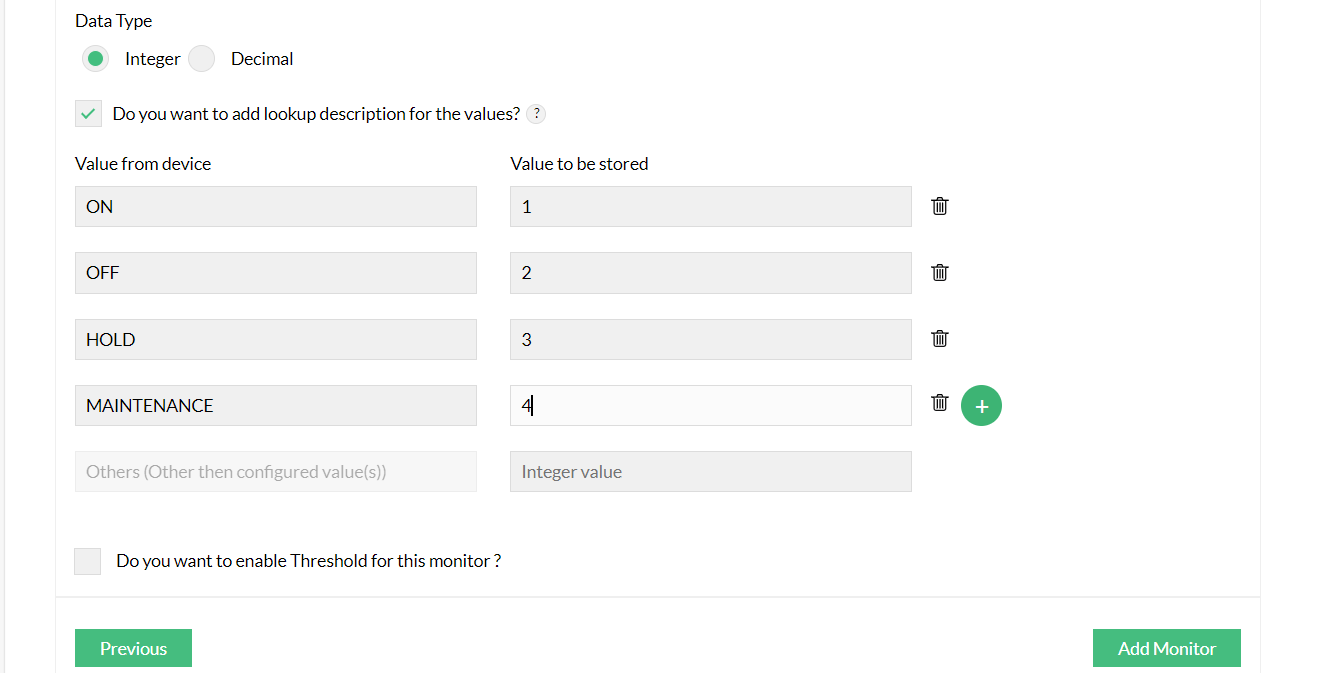By default, OpManager provides SNMP monitoring that can be used to monitor the health and performance of your SNMP-based network devices, and to track them in real-time. But in case these monitors do not meet your requirements, OpManager also provides you with an option to create custom SNMP monitors to get performance metrics based on vendor specific OIDs provided in the MIB.
Initially, we need to input the desired OID(s) and ensure that a valid response is returned by querying a device. The steps involved are as follows:
Example: (.1.3.6.1.2.1.1.3.0)/8640000
Currently, these are the expressions that are supported - Addition (+), Subtraction(-). Multiplication(*), Division (/), Modulus (%) and Max/Min operations (max(a,b) / min(a,b). Note that whenever you are providing OIDs anywhere in OpManager, they must always start with a period. (Example: .a.b.c.d.e.f.g.h)
E.g. In the case of adding an SNMP monitor to fetch the CPU temperature value, you can use a functional expression to convert Celsius to Fahrenheit. It also supports aggregate methods that allow you to perform operations which combine multiple values to give a single output. E.g. AverageOfColumnValues, SumOfColumnValues etc.
This "Query Device" option should be used to check whether the provided OID is giving the expected output value. If not, you need to go back to the OID configuration page and make the necessary changes for it to provide the correct response. Please proceed with the configuration process only after ensuring this.
An Object identifier (OIDs) can sometimes return multiple values, commonly called as Tabular objects. Depending on the OID chosen, the second "Graph details" window might contain more or fewer fields that need to be configured. If you chose an OID that returns a single value (either string or numeric), you can simply check if the response is valid and click "Next".
If you chose an OID that returns multiple values, you need to proceed to configure the other fields as given below:
OpManager provides the option of selecting specific instances that you want to monitor from a Tabular object.
This checkbox the creation of separate SNMP monitors for each instance if multiple instances are available under an OID. If you choose to select this option, it is mandatory that you provide inputs to the Series Index and the Series Display Name fields.
The Series Index and the Series Display Name drop-down menu will automatically list all the OIDs under the same parent. If the index or description OIDs are not listed, you can type in the required OID
Kindly make sure that the selected Series Index OID returns its own instance as response. Similarly, for Series Display Name, make sure that the selected OID returns a description of each instance as response, which must further be unique.
For example:
[Series Index OID].7:-->7
[Series Index OID].6:-->6
[Series DisplayName OID].7:-->Description D
[Series DisplayName OID].6:-->Description C
Enter the lookup values that convert string values to the corresponding integer value and store them in the database.

You can check this option to set thresholds on the alerts that will be generated based on this monitor.
Select the condition [>, =, < or !=]for Attention, Trouble & Critical alert thresholds, and enter the values. An alert is raised if the monitored value is greater than, equal to, not equal to, or lesser than the specified threshold value, based on the condition selected.
For string-based thresholds, you can choose from the following conditions - CONTAINS, EQUALS, NOT CONTAINS, NOT EQUALS, MATCH REGEX. You can use these conditions to configure values for all levels of thresholds.
Rearm Value: Enter the Rearm Value for the monitor. A rearm value helps determine if the condition of a monitor has returned to normal after a threshold violation alert.
Example: Let us assume that the attention alert threshold for a memory monitor is configured as, 'Raise Attention alert when the monitored data is > 75' and the monitored memory value of that device exceeds this value, say 80. Then an alert will be raised.
In the next poll, if the monitored memory value is 72, deleting the raised alert might not be the best thing to do since the monitored value is still close to the threshold. This is where the Rearm value comes into play, by allowing you to provide a "reset" value for the monitor. Even if the monitored value gets lower than any of the threshold values, the raised alert is deleted only if the value goes below the Rearm value.
In the Consecutive Times field, enter the value of how many consecutive times the thresholds (Attention, Trouble and Critical) can be violated for an alert to be generated.
Custom SNMP monitors can be associated using any of the following three methods.
Go to Settings → Monitoring → Performance Monitors → Add Monitor to view the Add SNMP monitor window. You can create monitors using this method, and choose to associate them right away or later.
To add a new monitor from a device snapshot page, go to Inventory → Devices and then click on a device to open its snapshot page. Now from the snapshot page, navigate to Monitors → Performance Monitors → Actions → Add SNMP monitor. Note that monitors added in this manner are specific to only that device, and are not reflected anywhere else.
You can also go to Settings → Configuration → Device Templates, click on any template, click "Add" next to the Associated Monitors section and select "SNMP" from the categories mentioned. Monitors created using this method can be associated to devices to be discovered in the future, or also can be used to associate to devices in bulk.
Know more about SNMP monitoring in OpManager.
Thank you for your feedback!